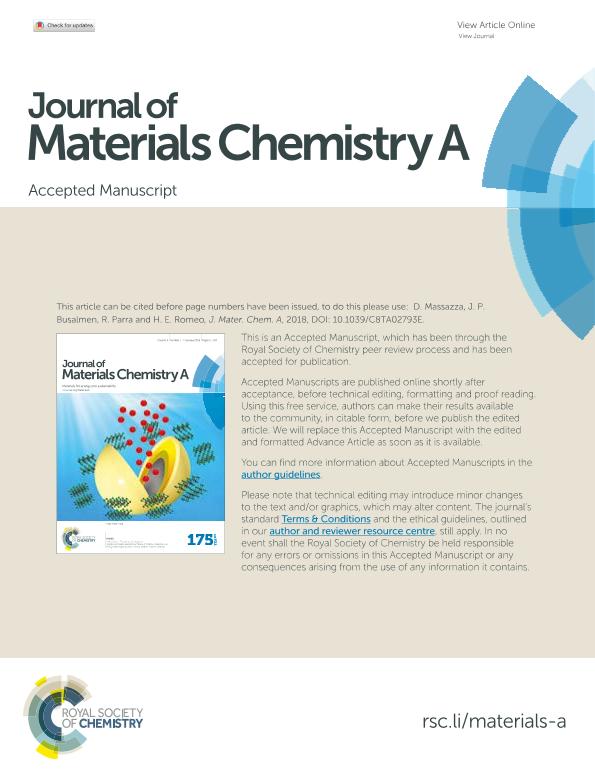Mostrar el registro sencillo del ítem
dc.contributor.author
Massazza, Diego Ariel

dc.contributor.author
Busalmen, Juan Pablo

dc.contributor.author
Parra, Rodrigo

dc.contributor.author
Romeo, Hernan Esteban

dc.date.available
2019-08-15T15:01:56Z
dc.date.issued
2018-04-24
dc.identifier.citation
Massazza, Diego Ariel; Busalmen, Juan Pablo; Parra, Rodrigo; Romeo, Hernan Esteban; Layer-to-layer distance determines the performance of 3D bio-electrochemical lamellar anodes in microbial energy transduction processes; Royal Society of Chemistry; Journal of Materials Chemistry A; 6; 21; 24-4-2018; 10019-10027
dc.identifier.issn
2050-7488
dc.identifier.uri
http://hdl.handle.net/11336/81645
dc.description.abstract
Microbial fuel cells (MFCs) harness the metabolic machinery of electro-active bacteria to transfer electrons from organic molecules to polarized anodes. In this context, increasingly higher anode surface areas have been pursued for maximizing MFC performance. In this study we prepared 3D layered Ti4O7 electrodes with different interlayer spacings (from 10 to 100 μm) but maintaining the same total void fraction (90%), so as to modify the electrode surface-to-volume ratios. This allowed us to test the hypothesis that there must be a limit in surface area per unit volume restricting the efficiency of 3D porous bio-electrochemical anodes. The lamellar scaffolds were evaluated in three-electrode cells cultured with G. sulfurreducens. Regardless of the electrode interlayer spacing or the biofilm developmental stage, the electron transfer rate was constant (0.11 pA per bacterium), with current scaling linearly with the size of the microbial population. However, maximum volumetric current densities (20 ± 0.8 kA m-3) were not obtained from electrodes with maximum surface-to-volume ratios (shorter interlayer distances), because bacterial biomass was not directly proportional to the surface area. This demonstrated that, by controlling the spacing between layers, it is possible to modulate the amount of bacteria per electrode unit volume, this ratio determining the final electrode performance. The limit obtained in surface area suggested that other effects, such as fluid dynamic constraints inside the "slit-shaped" pores, must be playing a critical role in anode performance.
dc.format
application/pdf
dc.language.iso
eng
dc.publisher
Royal Society of Chemistry

dc.rights
info:eu-repo/semantics/openAccess
dc.rights.uri
https://creativecommons.org/licenses/by-nc-sa/2.5/ar/
dc.subject
Biofilms
dc.subject
Electrodos Porosos
dc.subject
Sistemas Bioelectroquímicos
dc.subject
Bio-Electrochemical
dc.subject.classification
Físico-Química, Ciencia de los Polímeros, Electroquímica

dc.subject.classification
Ciencias Químicas

dc.subject.classification
CIENCIAS NATURALES Y EXACTAS

dc.subject.classification
Recubrimientos y Películas

dc.subject.classification
Ingeniería de los Materiales

dc.subject.classification
INGENIERÍAS Y TECNOLOGÍAS

dc.title
Layer-to-layer distance determines the performance of 3D bio-electrochemical lamellar anodes in microbial energy transduction processes
dc.type
info:eu-repo/semantics/article
dc.type
info:ar-repo/semantics/artículo
dc.type
info:eu-repo/semantics/publishedVersion
dc.date.updated
2019-08-01T20:26:22Z
dc.identifier.eissn
2050-7496
dc.journal.volume
6
dc.journal.number
21
dc.journal.pagination
10019-10027
dc.journal.pais
Reino Unido

dc.description.fil
Fil: Massazza, Diego Ariel. Consejo Nacional de Investigaciones Científicas y Técnicas. Centro Científico Tecnológico Conicet - Mar del Plata. Instituto de Investigaciones en Ciencia y Tecnología de Materiales. Universidad Nacional de Mar del Plata. Facultad de Ingeniería. Instituto de Investigaciones en Ciencia y Tecnología de Materiales; Argentina
dc.description.fil
Fil: Busalmen, Juan Pablo. Consejo Nacional de Investigaciones Científicas y Técnicas. Centro Científico Tecnológico Conicet - Mar del Plata. Instituto de Investigaciones en Ciencia y Tecnología de Materiales. Universidad Nacional de Mar del Plata. Facultad de Ingeniería. Instituto de Investigaciones en Ciencia y Tecnología de Materiales; Argentina
dc.description.fil
Fil: Parra, Rodrigo. Consejo Nacional de Investigaciones Científicas y Técnicas. Centro Científico Tecnológico Conicet - Mar del Plata. Instituto de Investigaciones en Ciencia y Tecnología de Materiales. Universidad Nacional de Mar del Plata. Facultad de Ingeniería. Instituto de Investigaciones en Ciencia y Tecnología de Materiales; Argentina
dc.description.fil
Fil: Romeo, Hernan Esteban. Consejo Nacional de Investigaciones Científicas y Técnicas. Centro Científico Tecnológico Conicet - Mar del Plata. Instituto de Investigaciones en Ciencia y Tecnología de Materiales. Universidad Nacional de Mar del Plata. Facultad de Ingeniería. Instituto de Investigaciones en Ciencia y Tecnología de Materiales; Argentina
dc.journal.title
Journal of Materials Chemistry A
dc.relation.alternativeid
info:eu-repo/semantics/altIdentifier/url/http://pubs.rsc.org/en/Content/ArticleLanding/2018/TA/C8TA02793E
dc.relation.alternativeid
info:eu-repo/semantics/altIdentifier/doi/http://dx.doi.org/10.1039/C8TA02793E
Archivos asociados
